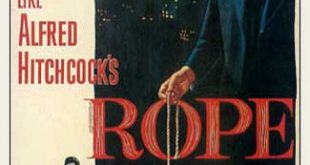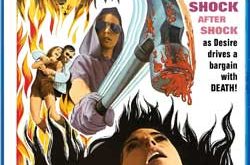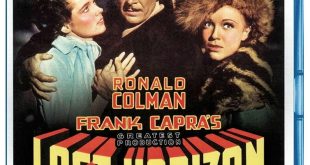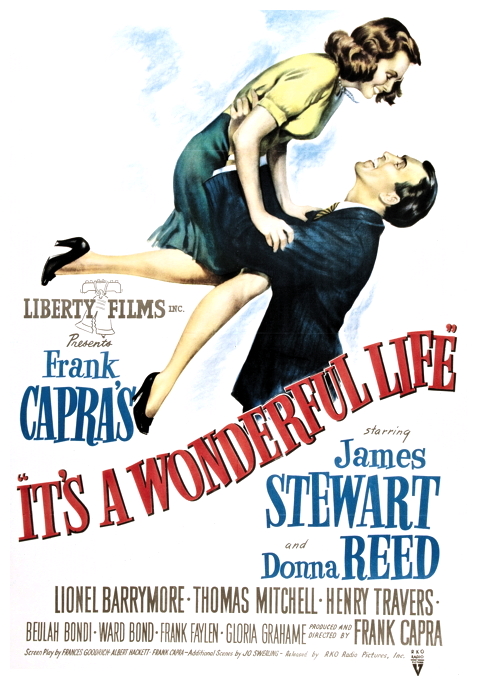 SYNOPSIS:
SYNOPSIS:
“George Bailey has spent his entire life giving of himself to the people of Bedford Falls. He has always longed to travel but never had the opportunity in order to prevent rich skinflint Mister Potter from taking over the entire town. All that prevents him from doing so is George’s modest building and loan company, which was founded by his generous father. But on Christmas Eve, George’s Uncle Billy loses the business’s $8,000 while intending to deposit it in the bank. Potter finds the misplaced money and hides it from Billy. When the bank examiner discovers the shortage later that night, George realizes that he will be held responsible and sent to jail and the company will collapse, finally allowing Potter to take over the town. Thinking of his wife, their young children, and others he loves will be better off with him dead, he contemplates suicide. But the prayers of his loved ones result in a gentle angel named Clarence coming to earth to help George, with the promise of earning his wings. He shows George what things would have been like if he had never been born. In a nightmarish vision in which the Potter-controlled town is sunk in sex and sin, those George loves are either dead, ruined, or miserable. He realizes that he has touched many people in a positive way and that his life has truly been a wonderful one.” (courtesy IMDB)
REVIEW:
In the animated Batman television series of the early nineties, Robin exclaims, “I can’t believe you’ve never seen It’s A Wonderful Life.” Batman replies, “I could never get past the title,” which I have no doubt reflects the attitude of moviegoers of the mid-forties. Unsuccessful when first released, rediscovered by film historians in the sixties, embraced with a vengeance by Baby Boomers in the seventies and eighties to the point where it had become a ubiquitous Christmas season irritant, It’s A Wonderful Life (1946) remains a wonderful movie indeed. Directed by Frank Capra at the peak of his considerable skills, it’s the populist auteur’s most personal creation, an overview of society, mortal existence and the preternatural importance of a single human life. Sentimental yet slyly subversive, the film is an ideal vehicle for ‘everyman’ star James Stewart, just back from serving in World War Two and himself uncertain about his own future. He and Capra caught lightning in a bottle with Mister Smith Goes To Washington (1939) and they do it all over again here – even if it took the public a tad longer than usual to realise it.
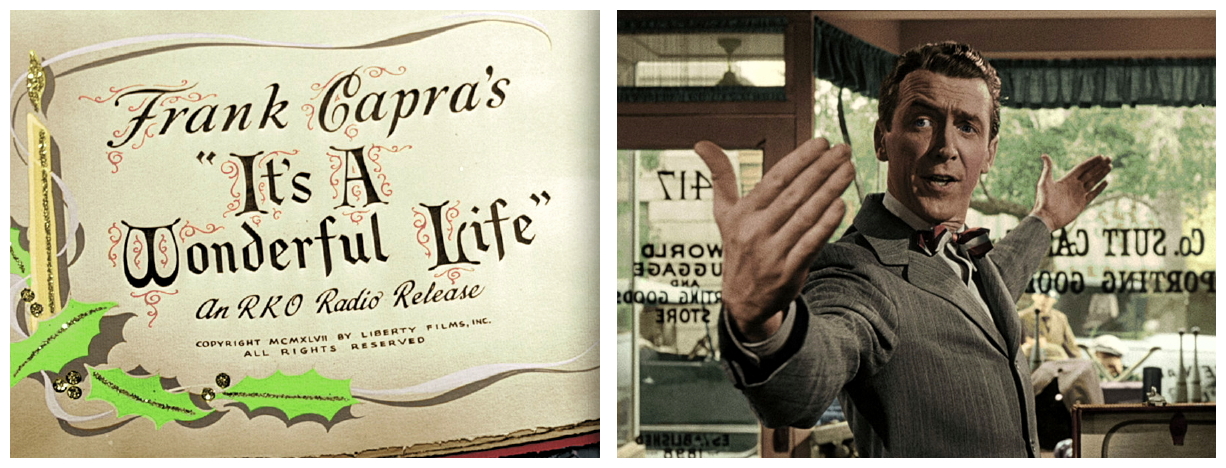 George Bailey (James Stewart) is one of the good guys. He thinks about other people, but he also thinks that his life has been so unfulfilled that we encounter him preparing to commit suicide by leaping from a bridge on Christmas Eve. Fortunately, angels have been reviewing his life and a novice, Clarence Odbody (Henry Travers), is sent to steer him back from the brink. Clarence reviews the life of Bailey, a decent man who has come to the end of his rope. Young George grows to maturity in the American hamlet of Bedford Falls, a town under the thumb of selfish scheming Henry F. Potter (Lionel Barrymore). Only Bailey’s Building-And-Loan stands between survival and bankruptcy for most of George’s neighbours, and he sacrifices his own ambitions to keep this humble institution alive. When a relative loses George’s money on Christmas Eve, he nearly does away with himself until Clarence steps in and shows him what life would have been like if he had never been born.
George Bailey (James Stewart) is one of the good guys. He thinks about other people, but he also thinks that his life has been so unfulfilled that we encounter him preparing to commit suicide by leaping from a bridge on Christmas Eve. Fortunately, angels have been reviewing his life and a novice, Clarence Odbody (Henry Travers), is sent to steer him back from the brink. Clarence reviews the life of Bailey, a decent man who has come to the end of his rope. Young George grows to maturity in the American hamlet of Bedford Falls, a town under the thumb of selfish scheming Henry F. Potter (Lionel Barrymore). Only Bailey’s Building-And-Loan stands between survival and bankruptcy for most of George’s neighbours, and he sacrifices his own ambitions to keep this humble institution alive. When a relative loses George’s money on Christmas Eve, he nearly does away with himself until Clarence steps in and shows him what life would have been like if he had never been born.
 Blessed with the love of his wife Mary (Donna Reed) and a plethora of grateful friends, Bailey soon discovers that, in all the important ways, he’s the richest man in town. The body of the movie is a review of episodes from George’s life in a small town, how he saved his younger brother from drowning, how he sacrificed his education and wish to travel the world on his brother’s behalf, his prudence in keeping his family’s finances in order despite hardship, his battle with the money-grabbing local banker and landlord, his marriage to his childhood sweetheart, and raising a family. Clarence arrives just in time to show George just how different Bedford Falls would have been without all of George’s efforts. George returns to his family and friends, who gather around the Christmas tree and determine to make his life better. The film reflects director Capra’s deep faith in the important values of community life, and in the essential goodness of most people.
Blessed with the love of his wife Mary (Donna Reed) and a plethora of grateful friends, Bailey soon discovers that, in all the important ways, he’s the richest man in town. The body of the movie is a review of episodes from George’s life in a small town, how he saved his younger brother from drowning, how he sacrificed his education and wish to travel the world on his brother’s behalf, his prudence in keeping his family’s finances in order despite hardship, his battle with the money-grabbing local banker and landlord, his marriage to his childhood sweetheart, and raising a family. Clarence arrives just in time to show George just how different Bedford Falls would have been without all of George’s efforts. George returns to his family and friends, who gather around the Christmas tree and determine to make his life better. The film reflects director Capra’s deep faith in the important values of community life, and in the essential goodness of most people.
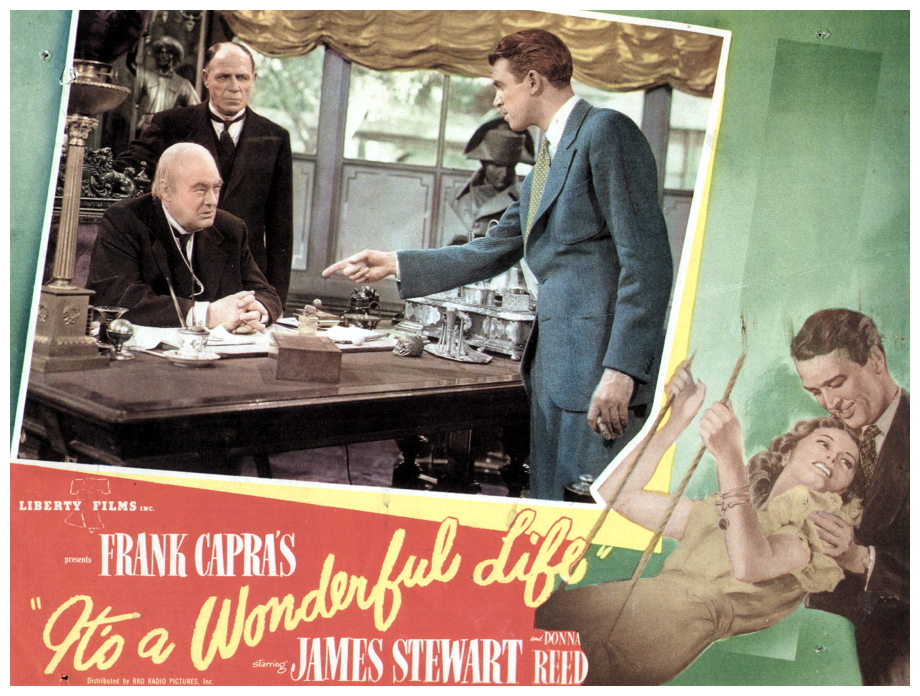 The idea for the film was based on a story called The Greatest Gift that writer Philip Van Doren Stern sent out as a Christmas greeting card. Capra was one of Hollywood’s most successful filmmakers during the Depression and World War Two years. His rags-to-riches story – one of a poor Sicilian Italian immigrant family who lived the American Dream, bluffing his way into Hollywood and being taken under the wing of Harry Cohn, founder of Columbia Pictures. He had a string of hits, beginning with It Happened One Night (1934), his first film to win all five top Oscars. He built a creative relationship with Gary Cooper in Mister Deeds Goes To Town (1936) and Meet John Doe (1941), and with James Stewart in You Can’t Take It With You (1938) and Mister Smith Goes To Washington (1939). All of these films deal with the idea of folksy idealistic common man having a real influence on people’s lives.
The idea for the film was based on a story called The Greatest Gift that writer Philip Van Doren Stern sent out as a Christmas greeting card. Capra was one of Hollywood’s most successful filmmakers during the Depression and World War Two years. His rags-to-riches story – one of a poor Sicilian Italian immigrant family who lived the American Dream, bluffing his way into Hollywood and being taken under the wing of Harry Cohn, founder of Columbia Pictures. He had a string of hits, beginning with It Happened One Night (1934), his first film to win all five top Oscars. He built a creative relationship with Gary Cooper in Mister Deeds Goes To Town (1936) and Meet John Doe (1941), and with James Stewart in You Can’t Take It With You (1938) and Mister Smith Goes To Washington (1939). All of these films deal with the idea of folksy idealistic common man having a real influence on people’s lives.
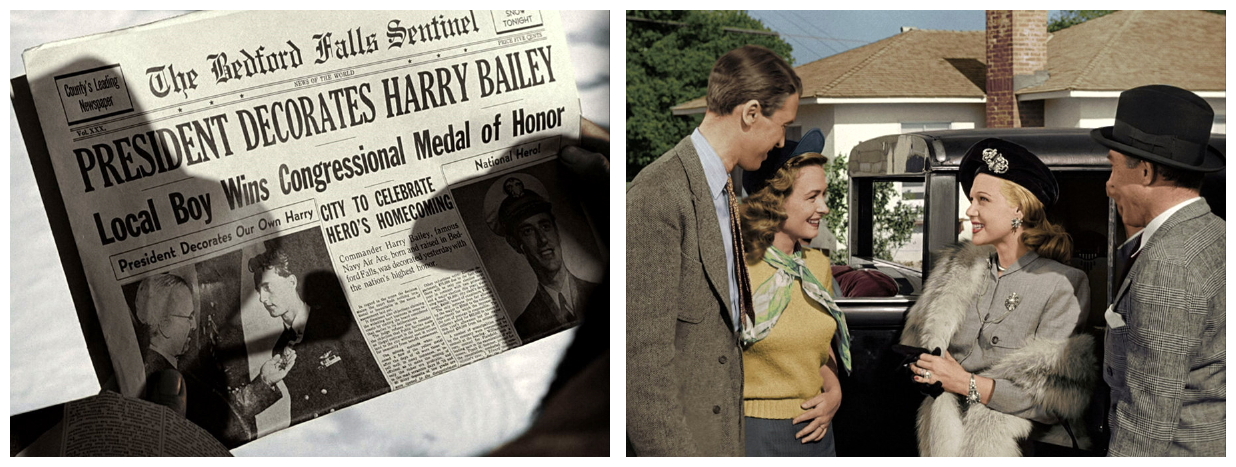 Although now one of the most popular Hollywood films ever made and a Christmas classic, It’s A Wonderful Life was not a hit at the time, and signaled a downturn in Capra’s popularity during the post-war years. George follows in the footsteps of other Capra idealists, who have their faith in themselves and their conservative values severely tested. But when he’s at the brink of giving up, his faith is restored by those very people he has spent a lifetime teaching through words and by example. Coming to his financial rescue in the tear-jerking finale, they prove to George that they have learned (while he has forgotten) his great lesson – people’s most important investments are not in stocks, bonds or property, but in each other. The film also allows Stewart to show how great an actor he was, as his character ranges from optimistic hick philosopher to the pessimistic post-war figure he’d play in Vertigo (1958) and the Anthony Mann westerns.
Although now one of the most popular Hollywood films ever made and a Christmas classic, It’s A Wonderful Life was not a hit at the time, and signaled a downturn in Capra’s popularity during the post-war years. George follows in the footsteps of other Capra idealists, who have their faith in themselves and their conservative values severely tested. But when he’s at the brink of giving up, his faith is restored by those very people he has spent a lifetime teaching through words and by example. Coming to his financial rescue in the tear-jerking finale, they prove to George that they have learned (while he has forgotten) his great lesson – people’s most important investments are not in stocks, bonds or property, but in each other. The film also allows Stewart to show how great an actor he was, as his character ranges from optimistic hick philosopher to the pessimistic post-war figure he’d play in Vertigo (1958) and the Anthony Mann westerns.
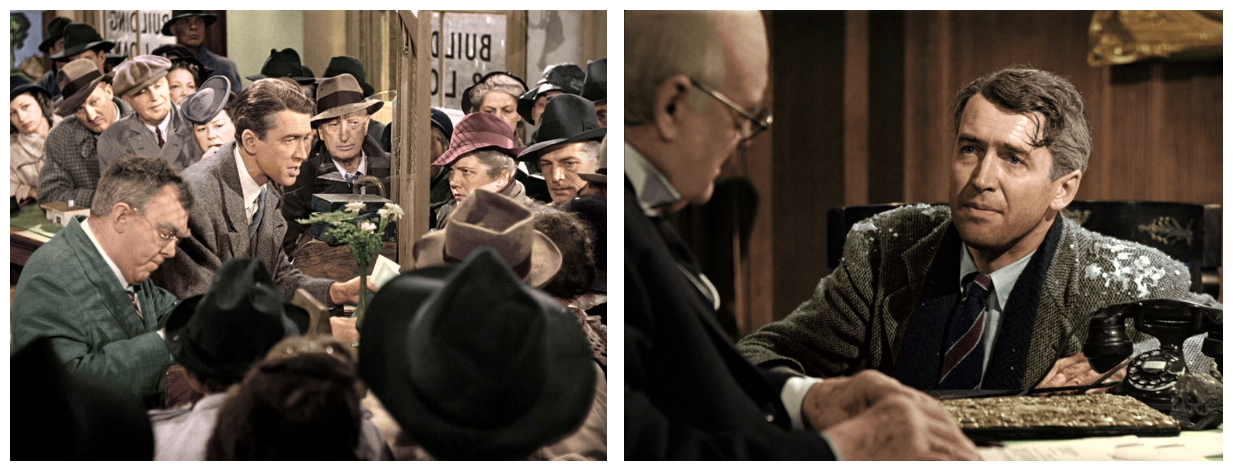 Likewise, the film ranges from riotous comedy to dreadful nightmare, allowing the rest of the wonderful cast to exhibit versatility. The eventual success of this film surely has to do with how reassuring it is – not only do you have a family who adores you, a hometown sweetheart who loves and marries you, a guardian angel who loves and protects you, but also an entire town of people who love you and come to your aid when you’re in trouble. Requiring an extended running time to chart a man’s life, the guardian angel set-up is nearly forgotten when it returns to the story more than an hour in. It’s actually a little annoying to switch from the heavy drama of George Bailey’s tear-and-tumble moment in the bar to magical Clarence jumping into the river. But once the ramifications of George’s non-existence begins to play out, the brilliance of this ‘What if?’ concept hits home with a wallop.
Likewise, the film ranges from riotous comedy to dreadful nightmare, allowing the rest of the wonderful cast to exhibit versatility. The eventual success of this film surely has to do with how reassuring it is – not only do you have a family who adores you, a hometown sweetheart who loves and marries you, a guardian angel who loves and protects you, but also an entire town of people who love you and come to your aid when you’re in trouble. Requiring an extended running time to chart a man’s life, the guardian angel set-up is nearly forgotten when it returns to the story more than an hour in. It’s actually a little annoying to switch from the heavy drama of George Bailey’s tear-and-tumble moment in the bar to magical Clarence jumping into the river. But once the ramifications of George’s non-existence begins to play out, the brilliance of this ‘What if?’ concept hits home with a wallop.
 Yes, it’s Capra’s version of Charles Dicken‘s A Christmas Carol, with impeccable wheelchair-bound Lionel Barrymore chewing the scenery as a Scrooge-like villain. Not to be overlooked is Donna Reed‘s sensitive performance as wife Mary, Thomas Mitchell as scene-stealing Uncle Billy, Ward Bond and Frank Faylen as the original Bert and Ernie, and the usual gang of lovable Capra character players: Beulah Bondi, H.B. Warner, Gloria Grahame, Todd Karns, Samuel S. Hinds, Frank Albertson, Virginia Patton, Sheldon Leonard and Karolyn Grimes. Still, the wonderful life in question belongs to Stewart’s George Bailey, the guy next door who tries to do the right thing and is stymied for his empathy and compassion. Capra nails Bailey’s existential despair throughout, never more effectively than when his brother returns to Bedford Falls with a surprise wife, sort-circuiting George’s dreams of escape.
Yes, it’s Capra’s version of Charles Dicken‘s A Christmas Carol, with impeccable wheelchair-bound Lionel Barrymore chewing the scenery as a Scrooge-like villain. Not to be overlooked is Donna Reed‘s sensitive performance as wife Mary, Thomas Mitchell as scene-stealing Uncle Billy, Ward Bond and Frank Faylen as the original Bert and Ernie, and the usual gang of lovable Capra character players: Beulah Bondi, H.B. Warner, Gloria Grahame, Todd Karns, Samuel S. Hinds, Frank Albertson, Virginia Patton, Sheldon Leonard and Karolyn Grimes. Still, the wonderful life in question belongs to Stewart’s George Bailey, the guy next door who tries to do the right thing and is stymied for his empathy and compassion. Capra nails Bailey’s existential despair throughout, never more effectively than when his brother returns to Bedford Falls with a surprise wife, sort-circuiting George’s dreams of escape.
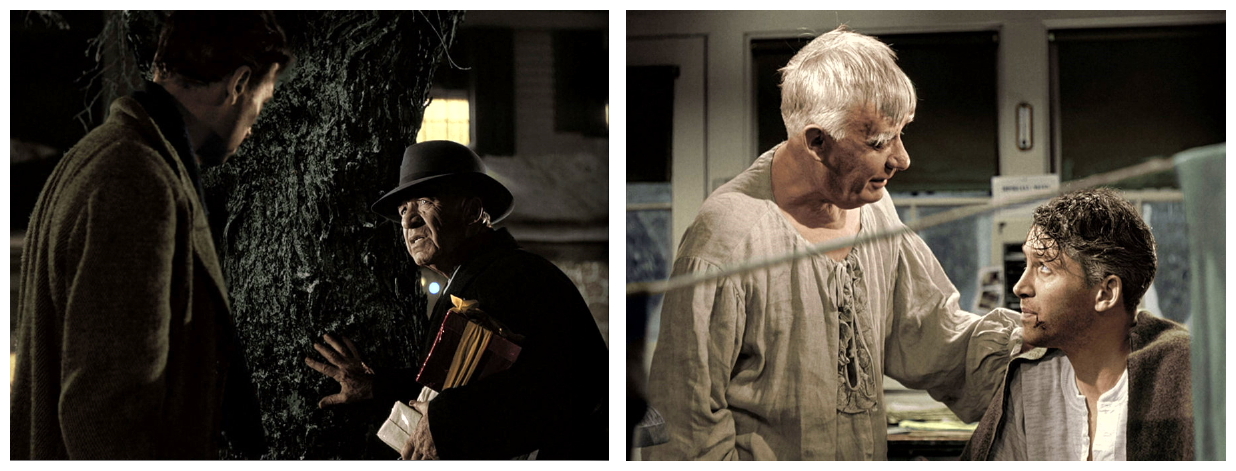 Using a steady tracking shot to capture Stewart’s tortured deep-in-thought profile, we watch his frown gradually brighten into a warm smile, as he greets Harry’s new bride and swallows this latest disappointment. It’s a bittersweet feeling of helplessness an emotion easily transmitted to most viewers. Still, It’s A Wonderful Life‘s buoyant optimism inevitably reverses all setbacks – hero George emerges from his personal purgatory to find renewal with beloved family and friends while the determined Clarence wins his well-deserved wings. Thank you for joining me here this week for my belated Horror News Christmas Special. I’m Nigel Honeybone, reminding you that nothing says ‘I couldn’t care less’ like one of twenty identical Christmas cards. Toodles!
Using a steady tracking shot to capture Stewart’s tortured deep-in-thought profile, we watch his frown gradually brighten into a warm smile, as he greets Harry’s new bride and swallows this latest disappointment. It’s a bittersweet feeling of helplessness an emotion easily transmitted to most viewers. Still, It’s A Wonderful Life‘s buoyant optimism inevitably reverses all setbacks – hero George emerges from his personal purgatory to find renewal with beloved family and friends while the determined Clarence wins his well-deserved wings. Thank you for joining me here this week for my belated Horror News Christmas Special. I’m Nigel Honeybone, reminding you that nothing says ‘I couldn’t care less’ like one of twenty identical Christmas cards. Toodles!
 Horror News | HNN Official Site | Horror Movies,Trailers, Reviews
Horror News | HNN Official Site | Horror Movies,Trailers, Reviews

